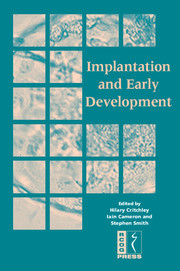Book contents
- Frontmatter
- Contents
- DECLARATION OF INTEREST
- Participants
- Preface
- SECTION 1 PREPARATION FOR IMPLANTATION – THE UTERINE ENVIRONMENT
- SECTION 2 THE EMBRYO
- 9 What makes a good egg?
- 10 What makes ‘good sperm’?
- 11 Morphogenesis of the early mammalian embryo: cell lineage heterogeneity and developmental potential
- 12 Epigenetics in development and cloning by nuclear transfer: alternative approaches to nuclear reprogramming
- 13 Risks associated with assisted reproduction: insights from animal studies
- 14 Pre-implantation genetic testing
- SECTION 3 LESSONS FROM ANIMAL MODELS (TRANSGENICS) AND NOVEL TECHNOLOGIES
- SECTION 4 CLINICAL SEQUELAE
- SECTION 5 CONSENSUS VIEWS
- Index
11 - Morphogenesis of the early mammalian embryo: cell lineage heterogeneity and developmental potential
from SECTION 2 - THE EMBRYO
Published online by Cambridge University Press: 05 June 2014
- Frontmatter
- Contents
- DECLARATION OF INTEREST
- Participants
- Preface
- SECTION 1 PREPARATION FOR IMPLANTATION – THE UTERINE ENVIRONMENT
- SECTION 2 THE EMBRYO
- 9 What makes a good egg?
- 10 What makes ‘good sperm’?
- 11 Morphogenesis of the early mammalian embryo: cell lineage heterogeneity and developmental potential
- 12 Epigenetics in development and cloning by nuclear transfer: alternative approaches to nuclear reprogramming
- 13 Risks associated with assisted reproduction: insights from animal studies
- 14 Pre-implantation genetic testing
- SECTION 3 LESSONS FROM ANIMAL MODELS (TRANSGENICS) AND NOVEL TECHNOLOGIES
- SECTION 4 CLINICAL SEQUELAE
- SECTION 5 CONSENSUS VIEWS
- Index
Summary
Introduction
The predominant morphological event occurring during mammalian pre-implantation development is the generation of a blastocyst with distinct cell lineages and with differing cell fates. This cell heterogeneity is an essential component of early morphogenesis and is associated with the maintenance of developmental potential for the embryo. Thus, as cleavage proceeds, cells either differentiate into an epithelium, the trophectoderm, which resides on the embryo surface, or remain relatively undifferentiated and occupy the central region of the embryo,forming the inner cell mass (ICM). The trophectoderm is responsible for active transport processes which collectively regulate exchange of ions, nutrients, metabolites, growth factors and other developmentally important molecules between the maternal tract and the embryo interior. It also generates the blastocoelic cavity of the blastocyst by transepithelial transport driven by Na, K-ATPase enzyme located on trophectoderm basolateral membranes. During blastocyst expansion, the ICM, located to one side of the blastocoel beneath the trophectoderm, segregates into epiblast (primary ectoderm) and hypoblast (primary endoderm) lineages, the latter forming adjacent to the blastocoel. After implantation, the trophectoderm and hypoblast give rise to extra-embryonic lineages while the epiblast is the progenitor of the entire fetus.
Keywords
- Type
- Chapter
- Information
- Implantation and Early Development , pp. 129 - 140Publisher: Cambridge University PressPrint publication year: 2005



